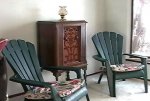Yeah, that's where my scanner has wound up, too! It used to be a good performer, with nice, clear audio and lots of sensitivity. The last time I tried to use it was when the fire alarm started sounding in this apartment building. It was nothing serious, just a false alarm, and attended to promptly by the fire dept., but I dragged out the scanner hoping to monitor the goings on and find out what set off the alarm. Without a display I was unable to key in their frequency properly, so I missed their communications. I believe a plumber working in our building had accidentally set off the alarm with smoke from his welding torch.I feel the same about my Yaesu VR5000 - a good DC-to-daylight receiver which worked well as a scanner too with many memories and a good alpha-numeric display which started losing lines both vertical and horizontal until it was unuseable. Many attempts to reseat the display on the rubber sandwich connector failed. It can still be used through a RS232 cable but only one of my computers/laptops/tablets have a Com port and the com-to-usb adaptors don't work. It sits in a drawer sulking now!
I used to have a Radio Shack DX-300 receiver that started losing segments, although that was an LED display. Besides radios, I've had several other devices with display problems. One of them was a PDA.
With all the talk here about features and performance, the main thing I want from a radio is reliability. It should continue to work as advertised, not break down a month after the warranty expires. Unfortunately, a reviewer can't always keep people informed about that, because maybe his radio didn't fail.
LCDs have been in existence for many years now, so you'd think that they could be made to last, especially if the user is not rough on his equipment. I never throw my devices around, or leave them in the hot sun, etc. When a device fails on me it's because it's a lemon. I've had enough of those to make a pitcher of lemonade.


